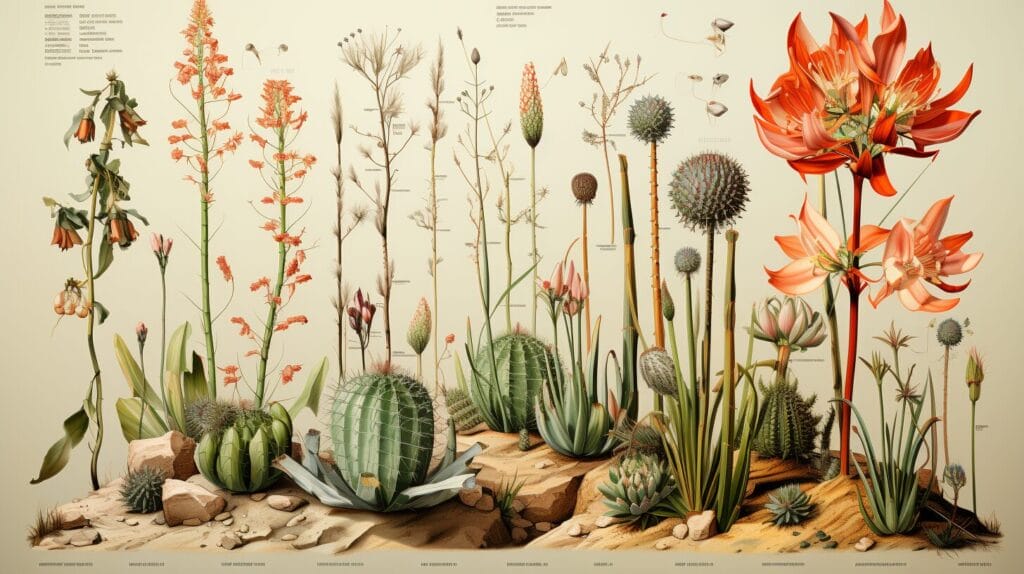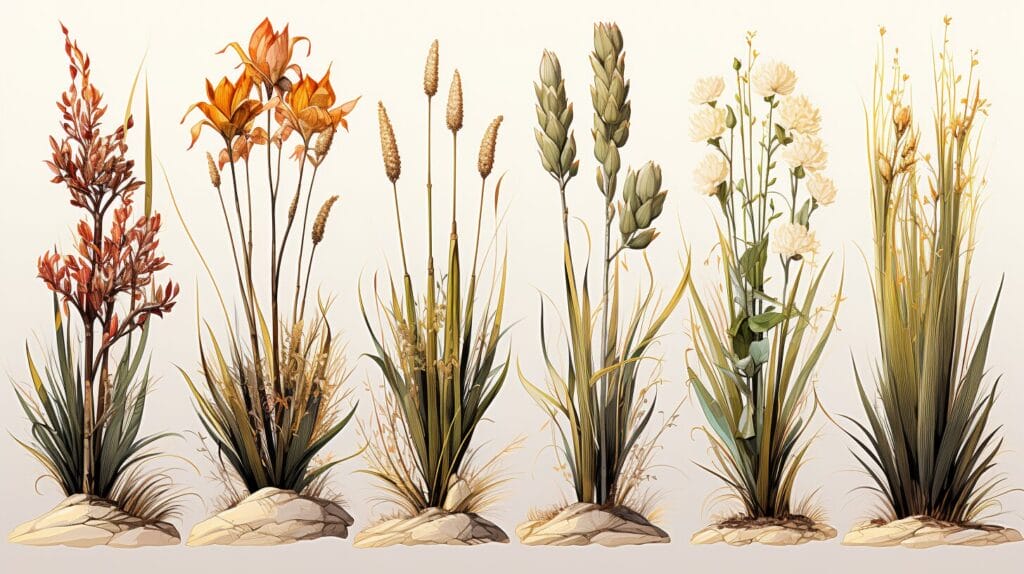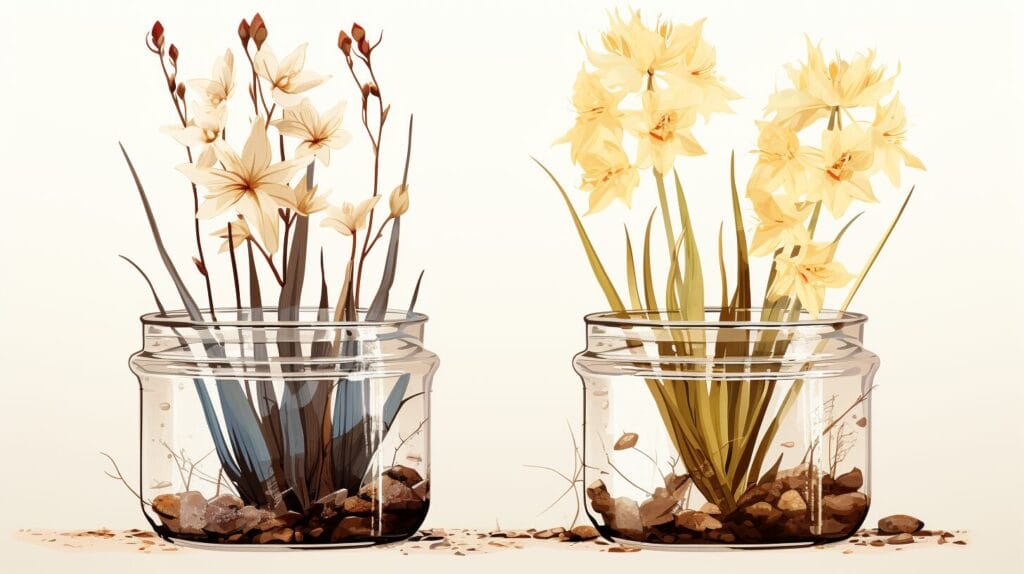Visual Guide to Yucca Plant Diseases Pictures: A Green Thumb’s Tool in 2024
Those of us who have a preference for horticulture frequently find ourselves lost in the verdant realm of nurseries, captivated by the lively allure of yucca plants. However, we’ve also known the sorrow of watching our beloved green paradises succumb to the disheartening darkness of disease.
We understand the frustration and helplessness that comes when our yuccas fall prey to silent, invisible enemies. That’s why we’ve crafted ‘Visual Guide to Yucca Plant Diseases: A Green Thumb’s Tool’—a comprehensive ally in the fight against these afflictions.
It’s time we armed ourselves with the knowledge to discern the subtle differences between symptoms, to tell nutrient deficiencies from pest invasions, and to understand the nuances of proper yucca care.
By exploring the guide’s insights, we’re not just leafing through pages; we’re turning over a new leaf in plant care, prepared to confront the challenges head-on.
And just when it seems like the battle is lost, our guide offers hope and tangible solutions that can make all the difference.
Join us as we uncover the secrets to keeping our yuccas thriving, and discover how the right information can transform us from casual plant enthusiasts into guardians of these desert jewels.
Key Takeaways
- Yucca plants can be affected by diseases such as leaf spot, root rot, and stem rot.
- Proper watering is crucial to prevent issues like yellowing leaves and root rot.
- Fungal and bacterial diseases, such as leaf spot and blight, can be prevented by planting yuccas in well-draining soil and ensuring good air circulation.
- Common pests in yuccas include aphids, mealybugs, and spider mites, which can be treated with insecticidal soap or neem oil.
Introduction to Yucca Plant and its Diseases

Yucca plants, with varieties like Yucca gloriosa and Spanish Bayonet, are hardy succulents but can fall prey to diseases such as leaf spot, root rot, and stem rot. These issues can compromise the health of our beloved plants, and we’re here to shed light on what to look out for and how to combat these problems.
Leaf spot is a common issue we see with yucca plants. It’s characterized by discolored, often brown, spots on the leaves. This fungal disease thrives in wet conditions, so we avoid overhead watering and provide ample air circulation. When we spot these unsightly blemishes, we act swiftly, removing affected leaves and applying a fungicide if necessary.
Root rot is another formidable adversary for yucca plants. Poorly draining soil is usually the culprit here. We’ve learned that ensuring proper drainage and watering judiciously is key to prevention. If our yuccas start to wilt or the base becomes mushy, it’s time to inspect the roots. Infected roots will be brown and soft, as opposed to the healthy, white, and firm roots we’re aiming for.
Stem rot, much like root rot, is a fungal disease that can seriously harm our yucca plants if left unchecked. It’s identified by soft, rotting stems, often accompanied by a foul odor. We tackle stem rot by cutting away the affected areas to healthy tissue and treating it with a fungicide.
Understanding these diseases and their symptoms is crucial in maintaining the health of our yucca plants. With vigilance and the right care, we can prevent and treat these issues, ensuring our yuccas thrive for years to come.
Underwatering vs Overwatering: How Water Affects Yucca Plant Health

Striking a balance in watering routines is essential for the health of our yucca plants, as both overwatering and underwatering can lead to serious issues like yellowing leaves and root rot. We’ve got to be diligent about how much water we give these plants because their tolerance for error is slim.
Overwatering is a common mistake, especially among well-meaning gardeners. It can cause our yucca plants to develop a condition known as root rot, where the roots become too moist and start to decay. This can be devastating, as a healthy root system is crucial for nutrient uptake and overall plant stability.
Conversely, underwatering can lead to a different set of problems, such as yellow leaves, which are often a plant’s SOS signal for more moisture.
To keep our yucca plants thriving, we need to understand the signs and pitfalls of improper watering:
- Overwatering: Soggy soil, wilted or yellow leaves, and brown spots can indicate too much water.
- Underwatering: Dry soil, drooping leaves, and slow growth are tell-tale signs of insufficient watering.
- Yellow leaves: Often a symptom of watering issues, it’s a visual cue to reassess our watering schedule.
- Brown spots: These can be a sign of both overwatering and fungal infections, which are more likely in overly moist conditions.
- Rot: A sign of advanced overwatering, rot can spread if we don’t adjust our watering practices promptly.
Understanding these key points helps us provide the best care for our yucca plants, ensuring they remain a vibrant part of our green spaces.
Fungal and Bacterial Diseases: Battling Leaf Spot and Blight in Yucca

While we’ve addressed the importance of proper watering, it’s equally crucial to recognize and combat the fungal and bacterial diseases that can plague yucca plants, such as leaf spot and blight. When inspecting your yucca’s foliage for signs of trouble, you might come across discolored, speckled leaves. These are often the telltale signs of leaf spot, a fungal disease that creates unsightly marks and can weaken your plant.
To battle these issues, we must first understand the causes. Fungal diseases like leaf spots thrive in conditions where the foliage remains damp for extended periods, often due to overwatering or poor air circulation. Blight, on the other hand, can rapidly deteriorate the plant’s leaves and stems, leading to widespread damage. It’s crucial to act swiftly at the first sign of these diseases.
Prevention is our best defense. Ensure your yucca is planted in well-draining soil and positioned in a location where air circulates freely, thus reducing the risk of fungal diseases. If you notice the early stages of leaf spot or blight, remove the affected leaves to prevent the spread.
In cases where the disease has taken a significant toll, we may need to resort to fungicides. It’s essential to choose a product specifically designed to combat the type of fungal disease your yucca is facing. Apply the fungicide according to the manufacturer’s instructions, covering all affected areas.
Bugs and Pests: Managing Infestations in Yucca

In our battle against yucca plant pests, recognizing the early signs of infestation is crucial for swift management and prevention. Many common pests, such as aphids, mealybugs, and spider mites, can wreak havoc on our beloved yuccas. We’re here to arm you with the knowledge to tackle these invaders with effective, plant-safe methods.
Consider these compelling points:
- Aphids: Tiny, sap-sucking insects that can cause yellowing and distortion of leaves.
- Mealybugs: White, cottony pests clustering in leaf axils, sapping the plant’s vigor.
- Spider Mites: Almost invisible critters weaving fine webs under leaves, leading to speckled foliage.
- Insecticidal Soap: A go-to, eco-friendly solution for treating soft-bodied pests without harming the plant.
- Neem Oil: A natural, systemic insecticide that disrupts the life cycle of pests and is safe for beneficial insects.
We need to act fast when we spot the telltale signs of pests, such as sticky honeydew left by aphids or the white fluff of mealybugs. A blast of water can dislodge many pests, but for persistent problems, insecticidal soap is a reliable choice. It’s important to thoroughly coat the insects and repeat applications as needed.
For a more holistic approach, neem oil is our ally. This powerful oil not only addresses the immediate infestation but also works preventatively by disrupting pest development. It’s a must-have in our green thumb toolkit.
With these strategies, we can manage infestations and protect our yucca plants from harm, ensuring they continue to thrive under our watchful care.
Comprehensive Yucca Plant Care to Prevent Diseases from Overpowering

Having armed ourselves against pests, it’s critical we now focus on overall yucca plant care to ward off diseases before they take hold. Proper care is the first line of defense against common problems that can plague these hardy plants. Let’s ensure we’re doing everything we can to keep our yuccas healthy and thriving.
A key aspect of yucca plant care is providing well-draining soil, as yuccas are susceptible to root rot if left in wet conditions. We must avoid overhead watering, which can leave moisture on the leaves and create an environment conducive to fungal diseases. Instead, we should water directly at the base of the plant.
Here’s a quick reference table to help us remember the best practices for yucca plant care:
| Care Aspect | Best Practice | Reason |
|---|---|---|
| Soil | Use well-draining soil | Prevents root rot and other diseases |
| Watering | Water at the base, not overhead | Reduces risk of leaf spot and crown rot |
| Temperature | Keep within ideal range | Protects plants from stress and disease |
| Fertilization | Apply correct amounts | Ensures healthy growth without overfeeding |
| Repotting | Do so when necessary | Enhances drainage and refreshes nutrients |
Can the Diseases Affecting Yucca Plants also Impact Other Types of Plants?
Some diseases affecting yucca plants, like wilting chili, can also impact other types of plants in the area. This can be a problem for gardeners trying to maintain healthy plant life. It’s important to identify the causes and fixes for wilting chili to prevent the spread of disease to other plants.
Conclusion
We’ve journeyed through the perils yucca plants face, from thirst to floods, fungi to pests. Now armed with our visual guide, we’re ready to spot trouble and act fast.
Let’s stay vigilant, provide the right care, and keep our yuccas thriving. Together, we can outsmart these diseases and celebrate the resilience of our green companions. Our yuccas depend on us, and we won’t let them down.
Here’s to healthy plants and happy gardening!
Frequently Asked Questions
Why are my yucca leaves turning yellow?
There can be several factors to yucca leaves turning yellow. It could be a sign of overwatering. If the yucca plant is watered excessively, the roots can rot, leading to yellowing leaves. Another possible reason is nutritional deficiency. Like most succulent plants, yucca needs a certain amount of specific nutrients to maintain its green color. If the plant lacks these nutrients, it could lead to yellowing. Similarly, intense direct sunlight can cause the yucca plant’s leaves to turn yellow due to sunburn.
Is my yucca plant dying if it has yellow leaves like in the yucca plant diseases pictures?
Yellow leaves are a sign that your yucca plant may be under stress. This doesn’t necessarily mean your plant is dying, but it needs some attention. It could be a signal of several issues, like overwatering, inadequate sunlight, temperature stress, or lack of certain nutrients. It’s best to identify and address the problems as soon as possible.
Are there special considerations when growing yucca plants?
Yes, there are a few things to consider when growing yucca plants. They need well-drained soil, a warmer environment, adequate sunlight, and moderate water. Make sure not to overwater the plant as it can lead to root rot. Also, feeding them with fertilizer during the growing season can make them thrive.
How do I know my yucca plant is about to bloom?
When a yucca plant is about to bloom, you will notice a tall, narrow stalk growing from the center of the plant. This stalk will eventually produce beautiful white flowers.
Why are yucca leaves showing gray discoloration?
Gray discoloration in yucca leaves might be a sign of a condition called Gray Leaf Spot. This disease is a fungal infection that begins as small, water-soaked lesions. These eventually become larger and turn into gray spots. Temperature stress and high humidity can increase the chance of a plant getting this disease.







